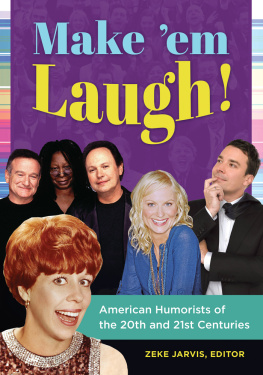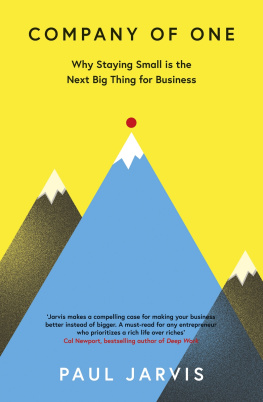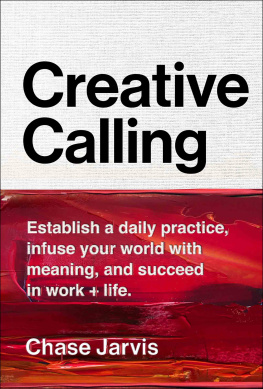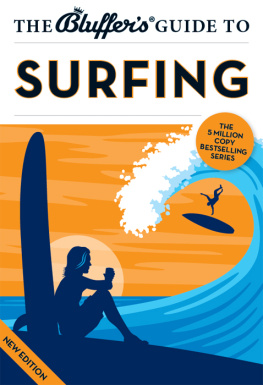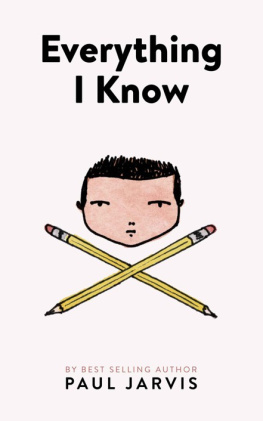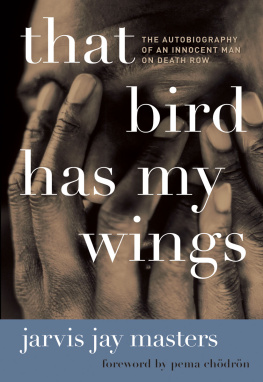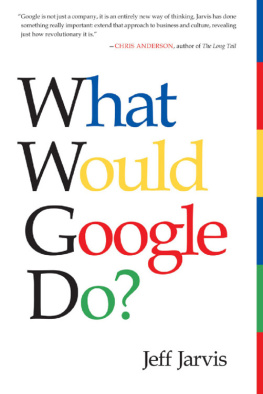Jarvis - Make em laugh!: American humorists of the 20th and 21st centuries
Here you can read online Jarvis - Make em laugh!: American humorists of the 20th and 21st centuries full text of the book (entire story) in english for free. Download pdf and epub, get meaning, cover and reviews about this ebook. City: United States, year: 2015, publisher: ABC-CLIO, LLC;Greenwood, genre: Detective and thriller. Description of the work, (preface) as well as reviews are available. Best literature library LitArk.com created for fans of good reading and offers a wide selection of genres:
Romance novel
Science fiction
Adventure
Detective
Science
History
Home and family
Prose
Art
Politics
Computer
Non-fiction
Religion
Business
Children
Humor
Choose a favorite category and find really read worthwhile books. Enjoy immersion in the world of imagination, feel the emotions of the characters or learn something new for yourself, make an fascinating discovery.
- Book:Make em laugh!: American humorists of the 20th and 21st centuries
- Author:
- Publisher:ABC-CLIO, LLC;Greenwood
- Genre:
- Year:2015
- City:United States
- Rating:5 / 5
- Favourites:Add to favourites
- Your mark:
- 100
- 1
- 2
- 3
- 4
- 5
Make em laugh!: American humorists of the 20th and 21st centuries: summary, description and annotation
We offer to read an annotation, description, summary or preface (depends on what the author of the book "Make em laugh!: American humorists of the 20th and 21st centuries" wrote himself). If you haven't found the necessary information about the book — write in the comments, we will try to find it.
Make em laugh!: American humorists of the 20th and 21st centuries — read online for free the complete book (whole text) full work
Below is the text of the book, divided by pages. System saving the place of the last page read, allows you to conveniently read the book "Make em laugh!: American humorists of the 20th and 21st centuries" online for free, without having to search again every time where you left off. Put a bookmark, and you can go to the page where you finished reading at any time.
Font size:
Interval:
Bookmark:
Make em Laugh!
American Humorists of the
20th and 21st Centuries
ZEKE JARVIS, EDITOR

Copyright 2015 by ABC-CLIO, LLC
All rights reserved. No part of this publication may be reproduced, stored in a retrieval system, or transmitted, in any form or by any means, electronic, mechanical, photocopying, recording, or otherwise, except for the inclusion of brief quotations in a review, without prior permission in writing from the publisher.
Library of Congress Cataloging-in-Publication Data
Make em laugh! : American humorists of the 20th and 21st centuries / Zeke Jarvis, editor.
pages cm
Includes bibliographical references and index.
ISBN 9781440829949 (cloth : alk. paper) ISBN 9781440829956 (ebook)
1. Humorists, American20th centuryBiographyDictionaries. 2. Humorists, American21st centuryBiographyDictionaries. 3. Authors, American20th centuryBiographyDictionaries. 4. Authors, American21st centuryBiographyDictionaries. 5. ComediansUnited StatesBiographyDictionaries. I. Jarvis, Zeke, editor.
PS430.M362015
817.509dc23 [B]2014040154
ISBN: 9781440829949
EISBN: 9781440829956
191817161512345
This book is also available on the World Wide Web as an eBook.
Visit www.abc-clio.com for details.
Greenwood
An Imprint of ABC-CLIO, LLC
ABC-CLIO, LLC
130 Cremona Drive, P.O. Box 1911
Santa Barbara, California 93116-1911
This book is printed on acid-free paper 
Manufactured in the United States of America
This work represents the culmination of decades of careful study and practice of humor. Special thanks go to the contributors: Dr. Stephen Powers, Brian Davis, and Kristen Franz. While this text represents a thorough study of American humorists, an exhaustive study would be impossible because of the pace with which the canon of American humor expands. As such, this book should serve as an effective launching point for future studies into an exciting and growing field.
Humor has not received the amount of scholarly attention that other forms of art such as tragedy or horror have. Indeed, it might be assumed that scholars are afraid of analyzing humor. The terms serious and humorous are often seen as opposites, which might feed into the lack of serious investigation of humor. When they do approach humor, many scholars might discuss how humor is unstable or unpredictable, or might give a description of why a pun was clever (often in a footnote that explains a reference that todays readers do not understand). Other scholars simply skip talking about humor at all, focusing instead on more traditionally investigated literary topics, even when the piece that they are discussing is genuinely funny.
Of course, scholars might also have good reasons for not spending time talking about humor. E.B. White might have put it best when he compared humor to a frog, saying that when someone tries to dissect it, it dies on the table, and you dont learn much from itmeaning that trying to analyze humor does more to make it stop being fun than it does to teach us anything. But that does not automatically mean that we should not think about humor. Instead, it might tell us that the best way to learn about humor is to be exposed to itthat is, to read funny things, to hear funny people talk, and to watch funny movies and skits in the same way that a biologist might study a frog by observing it its habitat and watching it move instead of trying to look at it when it is already dead. Unlike some forms of learning that are laid out with clear rules (it might be tempting to say algebra would be an example, but many readers might feel as if this subject lacks clear rules), the lack of hard-and-fast rules in comedy might very well make the most effective training a careful observation of humor.
That said, to get a full view of the subject of humor, this text tries to take a very broad view of humor so as to see as many different aspects of humor as possible. While this text does not necessarily include the complete humorous pieces themselves (although it provides some summaries of books and selected quotations from stand-up routines, movies, and television shows), it does give readers a good sense of where to turn for some of the best and most noteworthy humor produced in the United States in the last century. In fact, this books focus is not simply humor as an entire body of work. Instead, it addresses American humor, which is often different in nature and execution from British, Eastern European, or Latin American forms of humor, which might often be characterized as subtle, dark, or offbeat, respectively. While American humor can be all of these things (Americas cultural diversity can be seen in many of its cultural forms, and humor is definitely one of those forms), it also has some unique characteristics. Thus this book is an encyclopedia of both the forms of humor and the history and culture of 20th- and early 21st-century America. From the shock and horror expressed by Edna St. Vincent Millay and Dorothy Parker over the coming of World War II to the celebration of absurdity that can be found in present-day satirists like Stephen Colbert and The Onion, the concerns of various eras of U.S. history can easily be tracked through the style and content of Americas prominent humorists. Looking at the times and places that helped shape these works should add to the appreciation of each humorists significance and imagination. Indeed, one of humors strengths is its sense of playfulness, which can make humor the perfect vehicle for artistic innovation, because it is not limited by the seriousness of some other art forms.
With this focus on artistic breakthroughs in mind, although this text will definitely examine humor and it certainly values humor, this encyclopedia largely examines the issues of craft and technique found in each artists work as well as the social significance of these artists and their work. That said, its primary focus remains humor, so every entry will balance honoring the humor of a given artist with recognizing the overall historical significance of the artists cultural contribution.
New technology will always affect the way people communicate, and with each new form of communication, humorists find a way to play with the way that we have communicated in previous generations. Still, even as they push us away with one kind of strangeness or playfulness, they often try to pull readers in with something more familiar. In the early decades of the 20th century, humorists such as Damon Runyon and Anita Loos observed and wrote about the worlds they saw, bringing the underworld (in the case of Runyon) and the seedy underbelly of fame (in the case of Loos) to a larger, mainstream audience. While these two writers introduced new experiences and new types of characters to pop culture, they held onto familiar kinds of humor like puns, buffoons, and ridiculous plots.
Beyond new types or classes of characters and situations, American humorists found places to be a good source of comedy. At the beginning of the 20th century, there was still a strong focus on regionalism in literaturean influence stemming from Mark Twain and other humorists of earlier generations. This regionalism would continue with writers like Eudora Welty and Flannery OConnor, two Southern writers, but it was also seen in the work of Dorothy Parker and other members of the Algonquin Roundtable, whose quick wit and high-class references were clearly shaped by their time on the East Coast, particularly in the New York City area. As people became more mobile and magazines were more easily delivered across the country, the portrayal of specific groups or places became popular with both readers who had once lived in those places and the many people who liked to see those places poked fun of in print.
Next pageFont size:
Interval:
Bookmark:
Similar books «Make em laugh!: American humorists of the 20th and 21st centuries»
Look at similar books to Make em laugh!: American humorists of the 20th and 21st centuries. We have selected literature similar in name and meaning in the hope of providing readers with more options to find new, interesting, not yet read works.
Discussion, reviews of the book Make em laugh!: American humorists of the 20th and 21st centuries and just readers' own opinions. Leave your comments, write what you think about the work, its meaning or the main characters. Specify what exactly you liked and what you didn't like, and why you think so.

